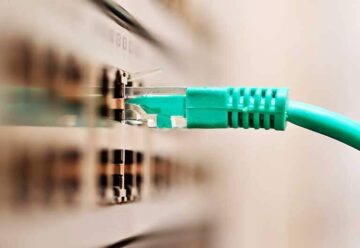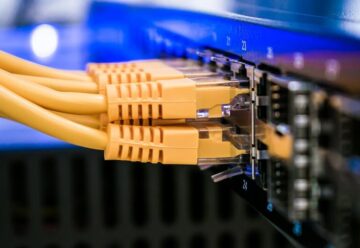Metro Ethernet is an Ethernet transport network used to connect sites across a city. Learn all about Metro Ethernet, the different types of Metro Ethernet services, and how they can benefit your business.
Get high-bandwidth business Ethernet
What’s Metro Ethernet
Metro Ethernet is a network that uses Ethernet standards to interconnect sites in a metropolitan area network (MAN). It’s a cost-effective, scalable way to connect multiple locations across a city or urban area.
Originally developed as a technology for local area networks (LANs), Ethernet used to have limited range and capacity. Today, Ethernet has evolved into Carrier Ethernet, which offers high-bandwidth data transmission over longer distances for wide area networks (WANs).
Metro Ethernet is a type of Carrier Ethernet used in a city location offering data transfer speeds of 1Mbps to 10Gbps.
What’s Metro Ethernet used for?
If you’re a business or network service provider, you can use Metro Ethernet in a metropolitan area network to:
- Interconnect your business offices or data centres
- Connect your business sites to the internet
- Provide IPTV, video conferencing and other collaboration tools via multicasting
- Connect your business sites to cloud services
- Deliver internet connectivity to business or domestic subscribers if you’re an internet service provider (ISP)
- Provide mobile backhaul services if you’re a mobile provider
In other words, you can connect all your sites in a city to the internet and the cloud in a single, scalable network.
What are the benefits of Metro Ethernet for businesses?
Metro Ethernet offers several advantages over traditional wide area networks, including:
- High speed: Metro Ethernet offers high bandwidth, providing fast connectivity with low latency.
- Cost-effectiveness: As Metro Ethernet networks are simpler, they can offer competitive prices for a given bandwidth.
- Ease of management: Ethernet standards are widely used in businesses, making Metro Ethernet easy to set up, manage and maintain.
- Scalability: Metro Ethernet networks typically use fibre optic cabling and can be scaled up to speeds of 10Gbps without significantly upgrading infrastructure.
- Flexibility: Metro Ethernet supports various topologies and configurations and different types of traffic, including voice, data and video.
- Reliability: Metro Ethernet supports Quality of Service (QoS) for critical applications and Ethernet operations, administration, and maintenance (OAM) for easy troubleshooting.
Overall, Metro Ethernet gives you flexible, high-bandwidth connectivity across a city at a relatively low cost.
Get high-bandwidth business Ethernet
How does Metro Ethernet work?
Metro Ethernet uses switches and routers typically connected by fibre optic cable to create a point-to-point (P2P) or point-to-multipoint (P2MP) network.
A Metro Ethernet network comprises:
- A core network, which commonly uses multi-protocol label switching (MPLS), a routing method that directs data between nodes using short paths for maximum speed
- An aggregation/distribution network, which may use a passive optical network, Digital Subscriber Line (DSL) or microwave technology to route the data to end users
- Access devices, like optical network terminals or office routers, which connect to an end user’s devices
The physical arrangement of a Metro Ethernet network – the network topology – depends on the type of service.
Types of Metro Ethernet services
There are several types of Metro Ethernet services, as defined by the Metro Ethernet Forum, the non-profit association that sets Carrier Ethernet standards. Below are the main Metro Ethernet services and their network topologies:
Metro Ethernet services
| Service type | Topology | Description |
| E-Line (Ethernet Line Service) | Point-to-point | Directly connects two business sites |
| E-LAN (Ethernet LAN Service) | Multipoint-to-multipoint | Allows multiple sites to exchange data directly with each other |
| E-Tree (Ethernet Tree Service) | Rooted multipoint | Connects a central site to multiple sites, but the “leaves” (branch nodes) of the tree don’t exchange data directly |
| E-Access (Ethernet Access Service) | Network-to-network | Provides a local access connection to another carrier’s network |
Which Metro Ethernet service is right for you depends on the size and complexity of your network and your business priorities.
Our Metro Ethernet solutions
At Neos Networks, we offer a range of Metro Ethernet solutions with various network services and topologies to suit your needs. Here are some Ethernet services we can configure for your business.
Point-to-point Ethernet
Ethernet Private Line (EPL), a kind of E-Line service, provides point-to-point (P2P) connectivity between a pair of dedicated user network interfaces (UNIs) and allows for a high degree of transparency along the network.
Point-to-point Ethernet

If your business needs a private, high-bandwidth connection between two locations with low latency and high availability, EPL is an excellent choice.
Point-to-multipoint Ethernet
If you want to connect multiple sites, Ethernet Virtual Private Line (EVPL), another E-Line service, may be for you. EVPL can enable multiple Ethernet Virtual Connections (EVCs) per UNI to support point-to-multipoint (P2MP) connectivity.
Point-to-multipoint Ethernet

Both P2P and P2MP Ethernet provide the simplicity of private connections combined with the flexibility and scalability of MPLS technology across a range of bandwidths.
Any-to-any Virtual Private LAN Service (VPLS)
If you want the flexibility of any-to-any connectivity, an E-LAN service like Virtual Private LAN Service (VPLS) may work for you. VPLS is a type of virtual private network (VPN) that links multiple sites in a single domain through IP routing or MPLS.
Any-to-any VPLS

With VPLS, you can connect all your sites to the same secure, high-speed network with a flexible capacity of up to 10Gbps.
Network-to-Network Interface (NNI)
If you’re a larger business, our E-Access Network-to-Network (NNI) services may be ideal. With Point-to-NNI connectivity, you can connect multiple sites back to your network as efficiently as possible at bandwidths that suit your needs.
Point-to-NNI

Whatever kind of connectivity you need, we’ll be happy to design a cost-effective, scalable, high-speed network for your business, so get in touch.
Get high-bandwidth business Ethernet
Metro Ethernet FAQs
-
What’s the difference between Metro Ethernet and traditional Ethernet?
Ethernet is a technology commonly used to connect devices in local area networks (LANs). As demand grew to link multiple LANs in wide area networks (WANs), Ethernet evolved into Metro Ethernet, which can transport data over longer distances with higher bandwidth. Metro Ethernet is used to provide high-speed connectivity across a metropolitan area network (MAN).
-
How does Metro Ethernet differ from Carrier Ethernet?
Both Metro Ethernet and Carrier Ethernet are ethernet standards defined by the Metro Ethernet Forum (MEF), allowing long-distance, high-bandwidth data transmission over wide area networks. While Carrier Ethernet is a broad term comprising all MEF’s long-distance ethernet standards, Metro Ethernet is a subset of Carrier Ethernet designed to connect sites across a metropolitan area and beyond.
-
Does Metro Ethernet use fibre?
Yes, Metro Ethernet typically uses fibre optic cables to connect the core network. Fibre cables provide long-distance, high-capacity connectivity with low latency.
-
How fast is Metro Ethernet?
Metro Ethernet supports transmission speeds from 1Mbps to 10Gbps and is highly scalable. You can usually upgrade speeds dynamically without installing new infrastructure.
You might also like
We can connect you anywhere in the UK
Discover our network reach
Great news!
"[poscode]" can be reached with our
expanded network
Speak to a representatitive to discuss your options
Contact usLearn about our prices using our online tool, LIVEQUOTE
View LIVEQUOTESorry
"[poscode]" can not be reached with our
expanded network
Speak to a representatitive to discuss your options
Contact usLearn about our prices using our online tool, LIVEQUOTE
View LIVEQUOTE




